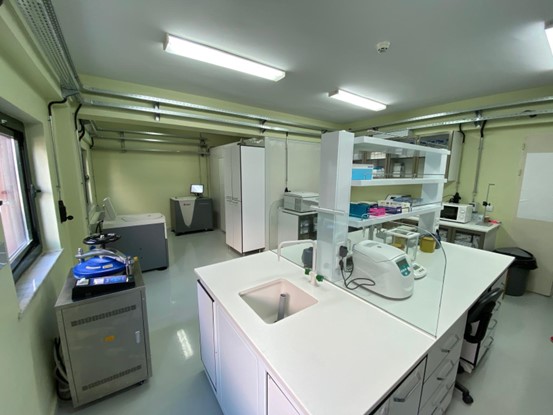TARLA Biotechnology Laboratory uses light to unravel the structures and dynamics of biologically important proteins and protein complexes for understanding the mechanisms of biological phenomena.
The research in TARLA Biotechnology Laboratory comprises molecular biology, recombinant or native protein production and purification, protein characterization, sample preparation for crystallography, electron microscopy or time-resolved laser absorption spectroscopy, structure modelling, biochemical measurements (enzyme kinetics), and complementary techniques such as cross-linking mass spectrometry, SAXS (Small Angle X-ray Scattering), and CD (Circular Dichroism) Spectroscopy.


Current Team
Mehmet Çalıseki, PhD student, Sabancı Üniversity, Molecular Biology and Genetics
Hatice Akkulak, PhD student, METU Biochemistry
Ataollah Nosratinia, PhD student, METU Biotechnology
Gizem Biter, MSc student, METU Chemistry
- Nurefşan Kuzucu, MSc student, Ege University, Biotechnology
Useyma Gülhan, MSc student, METU Biochemistry
Aleyna İrem Çilingir, TÜBİTAK 2247-C STAR Intern, METU Biology-Physics
Güzin Beyza Yıldız, TÜBİTAK 2247-C STAR Intern, METU Molecular Biology and Genetics
Membrane Protein Translocation and Quality Control
Membrane proteins are an important class of proteins for medical, pharmaceutical and biotechnological reasons, constituting more than 25% of the proteome of all cells. Membrane proteins need to be incorporated into the cell membrane, a process called protein translocation. In this process, protein quality control mechanisms are carried out by chaperones and proteases. BvK LaB investigates how these proteins and the complexes they form function and how they cooperate in membrane protein biogenesis from a structural biology perspective.
Investigation of Proteins Involved in Nitrogen Fixation
Industrially produced nitrogen fertilizers are based on the conversion of atmospheric nitrogen gas into bioavailable ammonium. This industry uses a large amount of energy, up to 5% of all fossil fuel use. In this way, current agricultural practices have become unsustainable. At the same time, serious environmental problems arise through the runoff of chemical fertilizers into aquatic ecosystems. Therefore, understanding biological nitrogen fixation will provide background information for researchers to develop next-generation sustainable agricultural strategies.
|
Research Lab Equipments |
Biotechnology Laboratory |
|
|
PCR Device (LongGene) |
Used in DNA amplification (multiplication), targeted mutations and analysis |
|
|
Horizontal Gel Electrophoresis System (Consort Horizontal Mini-Electrophoresis System) |
Used in the analysis of quantity and size of plasmids and PCR products on agarose gel and isolation |
|
|
Vertical Gel Electrophoresis System (Consort Vertical Electrophoresis System) |
Used in the analysis of quantity, purity and size of proteins (SDS-PAGE and native PAGE) |
|
|
Thermostatic Shaking Incubator (Biobase) |
Used in the growth of microorganisms in small and large scales in solid and liquid culture |
|
|
Refrigerated/non-refrigerated Centrifuges (Eppendorf/AllSheng) |
Used in the sedimentation, separation of small and large volume cell cultures and concentration of protein samples |
|
|
High Speed Centrifuge (Beckman Coulter Avanti JXN-26) |
Used for sedimentation and separation of large cultures |
|
|
Ultracentrifuge (Beckman Coulter Optima XPN-80) |
Used for separation of cell membranes and organelles. |
|
|
Ultrasonicator (Sonics) |
Used for breaking down cell walls. |
|
|
Autoclave (Ildam) |
Used for sterilization of various chemicals, nutrient media, materials, sanitation of waste materials and media. |
|
|
Ice Machine (Evermed) |
Used for providing cold working conditions in different experimental stages. |
|
|
Refrigerators (+4 oC)/Deep freezers (-20 and -80 oC) (Haier) |
Used for storage of various chemicals, cell culture stocks, produced proteins. |
|
|
Nanodrop (AllSheng Nano 300 w/ 600 nm option) |
Used for measuring protein and DNA concentrations, optical density measurements during the growth of cell cultures. |
|
 Turkish Accelerator and Radiation Laboratory (TARLA) Think Future, Think TARLA
Turkish Accelerator and Radiation Laboratory (TARLA) Think Future, Think TARLA